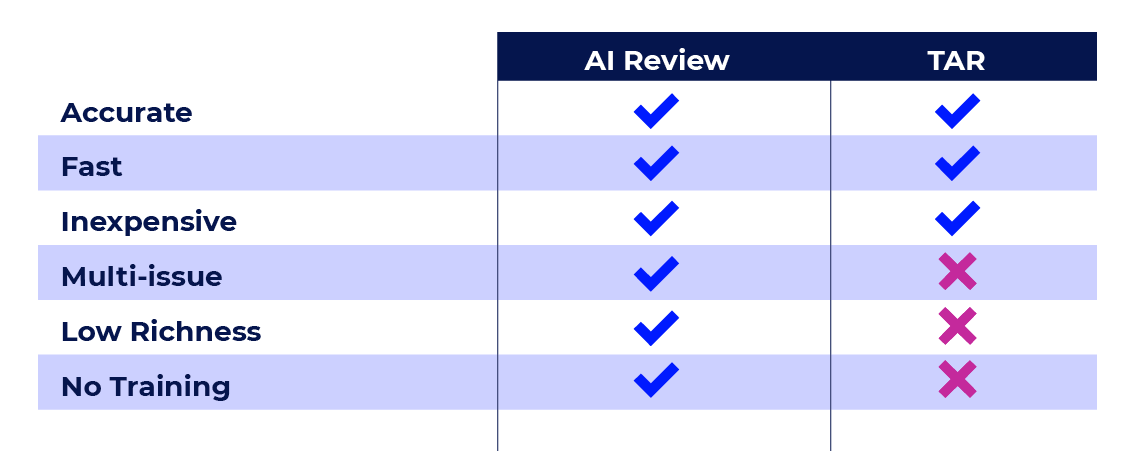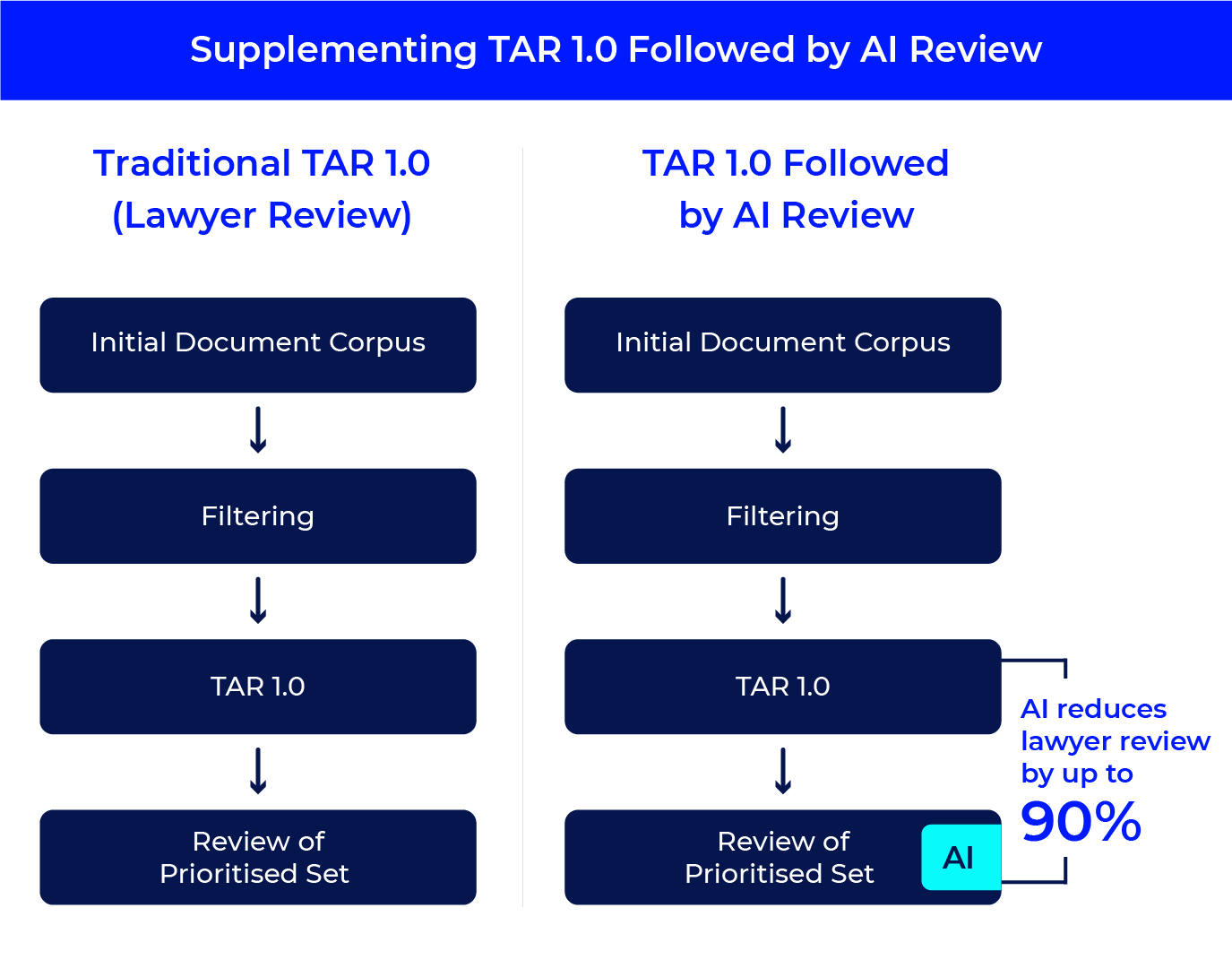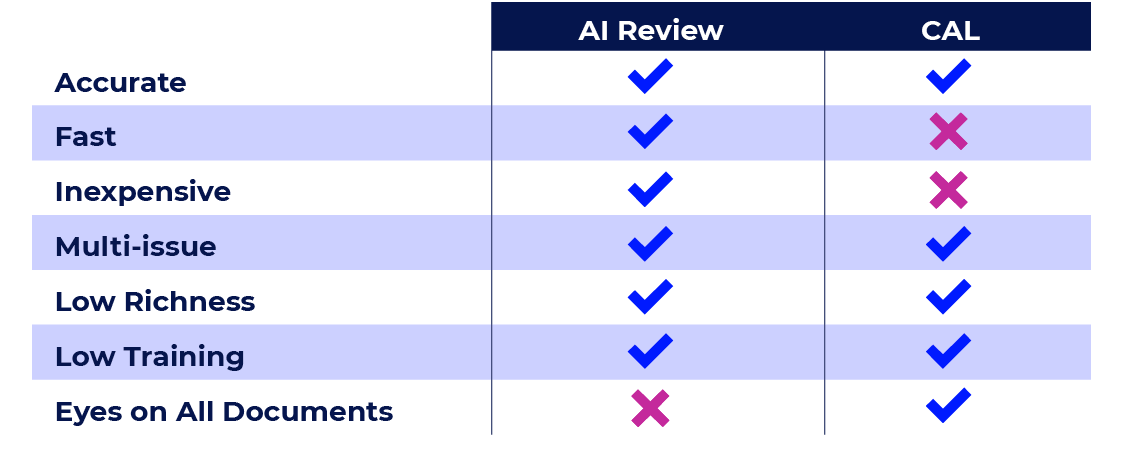

Angle

Transform Predictive Discovery Workflows With AI Review
- 3 Mins
Key Takeaway: AI review enhances Technology Assisted Review (TAR) by accelerating document review, improving consistency, and reducing costs. Legal teams streamline predictive workflows by combining AI with TAR 1.0 and Continuous Active Learning (CAL), enabling faster, more accurate discovery while minimizing manual effort and maximizing issue tagging precision.
Recent AI review capabilities based on generative AI and Large Language Model (LLM) technologies are disrupting legal discovery. Rather than replacing Technology Assisted Review (TAR), newer AI review platforms are proving to be powerful complements for legal teams. They enhance accuracy, reduce costs, and accelerate timelines. To truly transform predictive workflows, legal teams should supplement and train TAR 1.0 with AI review and combine Continuous Active Learning (CAL) with AI review for faster, more consistent, and cost-effective discovery.
Supplement TAR 1.0 Followed by AI Review
Modern discovery workflows often begin with filtering out non-relevant documents. TAR 1.0 is a reliable method for this, using a small training set to reduce large data volumes by up to seventy percent. However, the most expensive step, human review, is still necessary.
Enter AI review. When paired with TAR 1.0, AI manages the first-level review, tagging documents for relevance but also privilege and issue coding. The richer set is then sent to a team of lawyers for review. This reduces the need for extensive human review and speeds up production.

Traditional TAR 1.0 Approach Versus TAR 1.0 Followed by AI for Review:

Use AI Review To Train TAR Models
Training TAR models is resource-intensive, often requiring lawyers to manually code thousands of documents. AI review platforms review thousands of documents, typically reviewed by one or two subject matter experts, within a fraction of the time. This hybrid approach combines TAR’s filtering power with AI’s tagging precision, adding value through issue coding and sensitivity flags (e.g., Highly Sensitive and Potential Privilege).
Supplementing TAR With AI Review in Practice
Updating the lawyer review of the prioritized set following TAR is straightforward, but what about actually training the TAR model with AI review? In practice, that can be tricky. The savings in time and effort required to train a TAR model are valuable, but the case team must ensure that they are monitoring and validating the decisions the AI Review is making on their behalf, especially if the issues in the case are complex. The ability to document and clearly explain the process is critical. AI decisions carefully reviewed and confirmed by the case team will still save significant time and make the process more defensible.
Combine Continuous Active Learning With AI Review
CAL workflows rely on iterative human review to train models that help deprioritize the review of obviously non-relevant documents. AI review can be inserted into this cycle, replacing human reviewers with certain tranches of data. With each round, the CAL system gains new information and updates the stack ranking. For very low richness populations, using AI to power CAL review is an impactful combination of these technologies. This accelerates learning while maintaining quality through sampling and QC.

AI review is a powerful tool to review and issue tag documents, especially in reducing lawyer time in training TAR models and, critically, achieving higher consistency. TAR models suffer when document coding is inconsistent.
Since TAR has never been useful for issue coding, AI review takes the next step to replace first-level review. It provides an output that is coded for responsiveness, issue tags, “hot,” and potentially privileged information.
Humans are a vital part of this process. They remain responsible for validating both the predictive coding and LLM outputs before production. AI simply accelerates manual review, thereby freeing up time for higher-value work.
A combination of AI review and TAR will shine with:
- Large cases with costly training sets
- Projects requiring issue coding beyond responsiveness
- Tight deadlines
- Full second-level review before production
- Complex material that slows human reviewers
As legal departments seek to provide strategic value to their business, and law firms seek to stay competitive and reduce costs, combining AI review with traditional predictive coding offers teams a future-proof strategy for discovery.
Learn more about Epiq AI Discovery Assistant™.

Jon Lavinder, Senior Director, Project Management, Epiq
As Senior Director of Project Management at Epiq, Jon works closely with law firms and corporate legal professionals to build the tools and services for the next generation of legal discovery and information governance. He is a frequent speaker at eDiscovery conferences on the use of AI and the future of the industry.
The contents of this article are intended to convey general information only and not to provide legal advice or opinions.